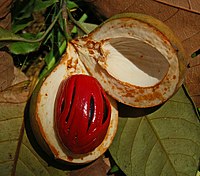
Photo from wikipedia
In cultivated plants, shoot morphology is an important factor that influences crop economic value. However, the effects of gene expression patterns on shoot morphology are not clearly understood. In this… Click to show full abstract
In cultivated plants, shoot morphology is an important factor that influences crop economic value. However, the effects of gene expression patterns on shoot morphology are not clearly understood. In this study, the molecular mechanism behind shoot morphology (including leaf, stem, and node) was analyzed using RNA sequencing to compare weedy (creeper) and cultivar (stand) growth types obtained in F7 derived from a cross of wild and cultivated soybeans. A total of 12,513 (in leaves), 14,255 (in stems), and 11,850 (in nodes) differentially expressed genes were identified among weedy and cultivar soybeans. Comparative transcriptome and expression analyses revealed 22 phytohormone-responsive genes. We found that GIBBERELLIN 2-OXIDASE 8 (GA2ox), SPINDLY (SPY), FERONIA (FER), AUXIN RESPONSE FACTOR 8 (ARF8), CYTOKININ DEHYDROGENASE-1 (CKX1), and ARABIDOPSIS HISTIDINE KINASE-3 (AHK3), which are crucial phytohormone response genes, were mainly regulated in the shoot of weedy and cultivar types. These results indicate that interactions between phytohormone signaling genes regulate shoot morphology in weedy and cultivar growth type plants. Our study provides insights that are useful for breeding and improving crops to generate high-yield soybean varieties.
Journal Title: Frontiers in Genetics
Year Published: 2022
Link to full text (if available)
Share on Social Media: Sign Up to like & get
recommendations!